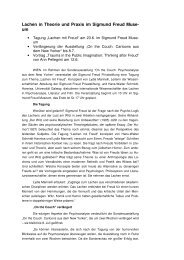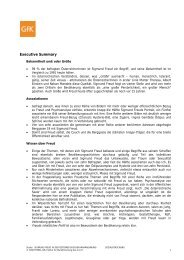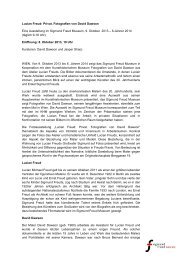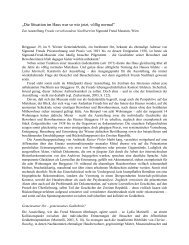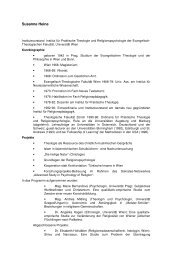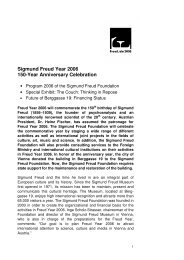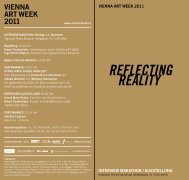Sigmund Freud-Museum | Newsletter - Sigmund Freud Museum Wien
Sigmund Freud-Museum | Newsletter - Sigmund Freud Museum Wien
Sigmund Freud-Museum | Newsletter - Sigmund Freud Museum Wien
Create successful ePaper yourself
Turn your PDF publications into a flip-book with our unique Google optimized e-Paper software.
many children had loved him. They present themselves as already animated and ready for relationship.<br />
People are not imagined as their “users” but as their companions.<br />
At MIT, a research group on “affective computing” works on the assumption that machines will not be<br />
able to develop humanlike intelligence without sociability and affect. The mission of the affective<br />
computing group is to develop computers that are programmed to assess their users’ emotional states<br />
and respond with emotional states of their own. In the case of the robotic doll and the affective<br />
computer, we are confronted with relational artifacts that demand that the human users attend to the<br />
psychology of a machine.<br />
Today’s relational artifacts include robot dogs and cats, some specially designed and marketed to<br />
lonely elders. There is also a robot infant doll that makes baby sounds and even baby facial<br />
expressions, shaped by mechanical musculature under artificial skin. This computationally complex<br />
doll has baby “states of mind.” Bounce the doll when it is happy, and it gets happier. Bounce it when it<br />
is grumpy and it gets grumpier.<br />
These relational artifacts provide good examples of how psychoanalysis might productively revisit old<br />
“object” theories in light of new “object” relations. Consider whether relational artifacts could ever be<br />
“transitional objects” in the spirit of a baby blanket or rag doll. For Winnicott, such objects (to which<br />
children remain attached even as they embark on the exploration of the world beyond the nursery) are<br />
mediators between the child’s earliest bonds with the mother, who the infant experiences as<br />
inseparable from the self, and the child’s growing capacity to develop relationships with other people<br />
who will be experienced as separate beings. The infant knows transitional objects as both almost<br />
inseparable parts of the self and, at the same time, as the first not-me possessions. As the child grows,<br />
the actual objects are left behind. The abiding effects of early encounters with them, however, are<br />
manifest in the experience of a highly charged intermediate space between the self and certain objects<br />
in later life. This experience has traditionally been associated with religion, spirituality, the perception<br />
of beauty, sexual intimacy, and the sense of connection with nature. In recent years, the power of the<br />
transitional object is commonly seen in experiences with computers.<br />
Just as musical instruments can be extensions of the mind’s construction of sound, computers can be<br />
extensions of the mind’s construction of thought. A novelist refers to “my ESP with the machine. The<br />
words float out. I share the screen with my words.”<br />
An architect who uses the computer to design goes even further: “I don’t see the building in my mind<br />
until I start to play with shapes and forms on the machine. It comes to life in the space between my<br />
eyes and the screen.” Musicians often hear the music in their minds before they play it, experiencing<br />
the music from within before they experience it from without. The computer similarly can be<br />
experienced as an object on the border between self and not-self.<br />
Traditionally, the power of objects to play this transitional role has been tied to the ways in which they<br />
enabled the child to project meanings onto them. The doll or the teddy bear presented an unchanging<br />
and passive presence. In the past, computers were also targets of projection; the machine functioned as<br />
a Rorschach or “second self.” But today’s relational artifacts take a decidedly more active stance. With<br />
them, children’s expectations that their dolls want to be hugged, dressed, or lulled to sleep don’t only<br />
come from the child’s projection of fantasy or desire onto inert playthings, but from such things as the<br />
digital dolls’ crying inconsolably or even saying: “Hug me!” or “It’s time for me to get dressed for<br />
school!”<br />
In a similar vein, consider how these objects look from the perspective of self psychology. Heinz<br />
Kohut describes how some people may shore up their fragile sense of self by turning another person<br />
into a “self object.”9 In the role of self object, the other is experienced as part of the self, thus in<br />
perfect tune with the fragile individual’s inner state. Disappointments inevitably follow. Relational<br />
artifacts (not as they exist now but as their designers promise they will soon be) clearly present<br />
themselves as candidates for such a role. If they can give the appearance of aliveness and yet not<br />
disappoint, they may even have a comparative advantage over people, opening new possibilities for<br />
narcissistic experience with machines. One might even say that when people turn other people into<br />
self-objects, they are making an effort to turn a person into a kind of “spare part.” From this point of<br />
view, relational artifacts make a certain amount of sense as successors to the always resistant human<br />
material.<br />
Just as television today is a background actor in family relationships and a “stabilizer” of mood and<br />
affect for individuals in their homes, in the near future a range of robotic companions and a web of



